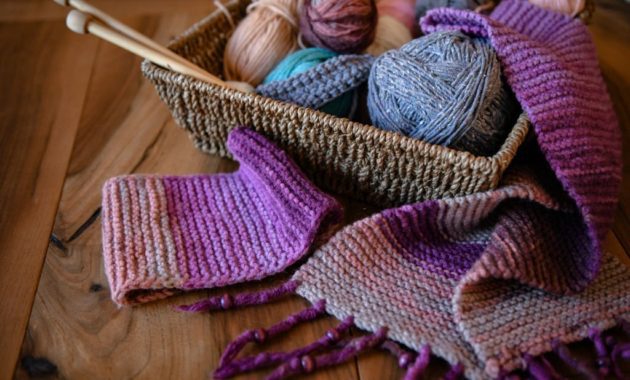
Crafting beautiful knitwear requires mastering various knitting increase techniques. Among them, M1 or “Make One” holds a special place, offering versatility and precision. M1 knitting, when executed correctly, provides virtually invisible increases, giving a polished finish to your projects. This post dives into the nuanced world of M1 knitting, exploring its history, techniques, and more.
The Basics of M1 Knitting
- Definition and the Role of M1 in Knitting:
At its core, M1 is a method to add stitches, increasing the overall count without a noticeable gap or hole. It serves as an integral part of numerous stitch patterns and techniques, enabling knitters to craft intricate designs with ease.
- Historical Evolution of the M1 Knitting Technique:
Historically, various cultures developed their own methods for adding stitches. M1 emerged as a favorite due to its discreet nature. Over time, with the advent of advanced knitting tutorials and shared knowledge, this method gained widespread popularity, becoming a staple in many knitters’ arsenals.
Differences Between M1L and M1R in Knitting
- Visual and Technical Differences:
M1L (Make One Left) and M1R (Make One Right) are tailored to either slant towards the left or the right. While M1L involves lifting the strand from front to back, M1R is its opposite. Visually, this means the stitches lean in corresponding directions, giving designers more control over the finished look.
- When to Use Each Technique in Projects:
Choosing between M1L and M1R depends on the desired design. For symmetric patterns, like shawls or blankets, alternating between the two can create a balanced look. For more intricate designs, the choice can influence the flow and orientation of patterns.
Tools and Materials Best Suited for M1 Knitting
- Recommendations for Needles and Yarn Types:
Smooth, medium-weight yarns are ideal for M1 knitting as they highlight the increase without added bulk. As for needles, a sharp-tipped needle, whether circular or straight, facilitates easier insertion, especially when working M1 knitwise or purlwise.
- Additional Tools to Enhance the M1 Knitting Experience:
Stitch markers can be invaluable, helping track increases and maintaining consistent patterns. Additionally, a knitting gauge can ensure your stitches and rows align with the desired dimensions.
Step-by-Step Guide to Perfecting M1 Knitting
- Detailed Instructions with Images/Illustrations:
While images can’t be displayed in this text, imagine a series of clear photos illustrating each step of the M1 process. Paired with concise captions, they’d guide readers through the journey, from yarn selection to the final stitch.
- Tips for Ensuring a Clean and Invisible Increase:
For a near-invisible result, always tighten the new stitch after making it. Also, practicing the technique in various yarns can help hone the skill, ensuring every M1 increase is as discreet as possible.
Common Mistakes in M1 Knitting and How to Avoid Them
- List of Typical Errors Knitters Encounter:
From leaving holes to misaligned stitches, errors can stem from not picking up the strand correctly or from inconsistencies in tension. Sometimes, tightening loose M1 stitches too much can distort the fabric.
- Solutions and Remedies for Each Mistake:
Regular practice, watching online tutorials, and occasionally consulting seasoned knitters can help troubleshoot and rectify common mistakes. Remember, every mistake is a learning opportunity.
Advanced M1 Knitting Techniques and Variations
- Exploring Innovative and Creative Uses of the M1 Increase:
Beyond traditional uses, M1 can be incorporated into lacework, cabled designs, or even in tandem with other increase techniques for unique textures.
- How to Integrate M1 Knitting in Complex Patterns:
When tackling intricate designs, chart out your pattern beforehand. This allows for strategic placement of M1 increases, ensuring the design remains uninterrupted and cohesive.
M1 Knitting vs. Other Increase Techniques
- Comparing M1 with Other Popular Knitting Increase Methods:
While yarn over offers an intentional hole, ideal for lace, the M1 method is more discreet. Similarly, the lifted increase technique might seem similar to M1, but it results in a tighter, less flexible fabric.
- Benefits and Challenges of Each Technique:
M1’s primary benefit is its invisibility, but it may be challenging for absolute beginners. On the other hand, yarn over is simpler but intentionally leaves gaps.
Practice Projects to Master M1 Knitting
- Suggestions for Beginners to Advanced Projects:
Start with a basic scarf or headband, gradually progressing to hats, socks, and finally, intricate shawls or garments. Each project level lets you refine your technique.
- Tips to Seamlessly Incorporate M1 Increases:
Always review your work after a few rows. This early check can help spot and rectify any errors, ensuring the final piece is flawless.
Mastering the M1 knitting technique can significantly elevate your knitting projects. From its discreet nature to its versatility, it’s a skill every knitter, whether novice or seasoned, should have in their repertoire. So, grab your knitting tools and needles and embark on this journey of crafting perfection. The world of M1 awaits!

Passionate about all things craft-related, I am a dedicated and creative craft blogger with a knack for turning ordinary materials into extraordinary masterpieces.
